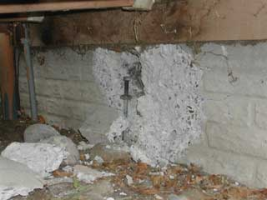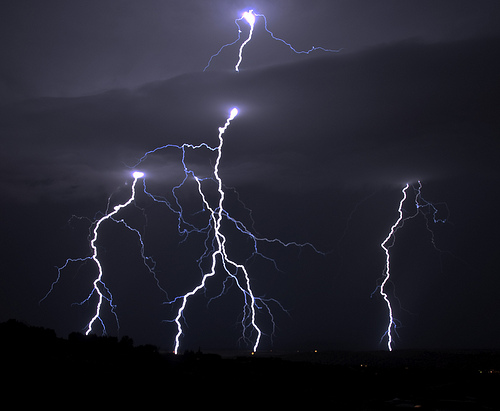-
Welcome to The Building Code Forum
Your premier resource for building code knowledge.
This forum remains free to the public thanks to the generous support of our Sawhorse Members and Corporate Sponsors. Their contributions help keep this community thriving and accessible.
Want enhanced access to expert discussions and exclusive features? Learn more about the benefits here.
Ready to upgrade? Log in and upgrade now.
You are using an out of date browser. It may not display this or other websites correctly.
You should upgrade or use an alternative browser.
You should upgrade or use an alternative browser.
Grounding to rebar in footer vs ground ro
- Thread starter bnymbill
- Start date
Yankee Chronicler
SAWHORSE
It is not "required" now. It is allowed, it's one of several options. The provisions allowing it date all the way back to the original 2000 IRC.
Your jurisdiction may have amended the model IRC. I researched it back through every edition of the ICC IRC from 2021 back to 2000.
Your jurisdiction may have amended the model IRC. I researched it back through every edition of the ICC IRC from 2021 back to 2000.
wwhitney
REGISTERED
Not familiar with the IRC's electrical chapters, but for the NEC, if the project scope includes installing a new concrete footing in direct contact with the earth, and the footing has 20' or more of #4 or larger rebar, then it is required to utilize at least one such footing as a Concrete Encased Electrode.It is not "required" now. It is allowed, it's one of several options.
Cheers, Wayne
jar546
CBO
It is required if present. New construction, absolutely, renovation, not necessarily if the rebar is not accessible.It is not "required" now. It is allowed, it's one of several options. The provisions allowing it date all the way back to the original 2000 IRC.
Yankee Chronicler
SAWHORSE
I phrased my response poorly, but the requirement goes all the way back to the 2000 IRC. The language changed between (IIRC) 2003 and 2006, but the requirement didn't change.
Good deal and thanks for the replies/help!
I have a new construction home being built and they put the ground rod that was bonded to the footer in front of the egress window. They had to grind that rod off at the slab. Now, they have to put a new ground rod in but no way to bond it to the footer at this point.
I have a new construction home being built and they put the ground rod that was bonded to the footer in front of the egress window. They had to grind that rod off at the slab. Now, they have to put a new ground rod in but no way to bond it to the footer at this point.
With the increased use of plastic water lines and the POCO's wanting their meter sockets grounded there has been a recent shift to a *Ufer type grounding system. I have seen foundation crews place TWO vertical rebar rods that stick up beyond the top of the poured foundation wall that are tied to the footings horizontal rebars at both ends of the foundation due to foundation crews not know the location of the houses main panel. They will spray paint theses rods orange, red or white to indicate they are to be used as a grounding source.
On the dufus side, I have seen the (GEC) coiled up on the inside of the foundation and later covered up by the concrete floor guy, said he didn't know what it was for?
FYI, for the ones that are non-experts.
After being asked in the field "What does Ufer mean?" I could tell them the purpose however after researching I found that Ufer is the name of the engineer Herbert G. Ufer, who developed the (CEE) concrete encased grounding electrode.
I had a smart-guy friend that knew a bit about grounding communication towers and he said "I don't want a house with that system!" and the curious George I' am, said why?
He explained "that if the house takes a lighting hit it could blow out the concrete wall!" and then you're left with a busted foundation issue!" I would think he'd have other issues as well.
I would like to know if anyone has seen the results of a lighting strike on a wall ufer set-up or would agree with that opinion?
On the dufus side, I have seen the (GEC) coiled up on the inside of the foundation and later covered up by the concrete floor guy, said he didn't know what it was for?
FYI, for the ones that are non-experts.
After being asked in the field "What does Ufer mean?" I could tell them the purpose however after researching I found that Ufer is the name of the engineer Herbert G. Ufer, who developed the (CEE) concrete encased grounding electrode.
I had a smart-guy friend that knew a bit about grounding communication towers and he said "I don't want a house with that system!" and the curious George I' am, said why?
He explained "that if the house takes a lighting hit it could blow out the concrete wall!" and then you're left with a busted foundation issue!" I would think he'd have other issues as well.
I would like to know if anyone has seen the results of a lighting strike on a wall ufer set-up or would agree with that opinion?
Yankee Chronicler
SAWHORSE
I had a smart-guy friend that knew a bit about grounding communication towers and he said "I don't want a house with that system!" and the curious George I' am, said why?
He explained "that if the house takes a lighting hit it could blow out the concrete wall!" and then you're left with a busted foundation issue!" I would think he'd have other issues as well.
I would like to know if anyone has seen the results of a lighting strike on a wall ufer set-up or would agree with that opinion?
I haven't seen a house with that grounding system that was struck by lightning, but I had the same concern when I first encountered the concept. A lightning strike will more than likely blow out the concrete around the rebar that's acting as the grounding conductor. I think it's a valid concern.
wwhitney
REGISTERED
Maybe so, but if the alternative is for that energy to be dumped into the rest of the electrical system, better to repair some concrete than extensively repair the electrical system.I haven't seen a house with that grounding system that was struck by lightning, but I had the same concern when I first encountered the concept. A lightning strike will more than likely blow out the concrete around the rebar that's acting as the grounding conductor. I think it's a valid concern.
Cheers, Wayne
The Ufer requirement came into the NEC code in 1978, but many jurisdictions tried to see a loophole in the language and did not require it. In the 2005 NEC, the language was clarified to make sure it would be enforced as originally intended. The IRC is a summarized version of the NEC for IRC houses, and is identical in purpose and intent to the NEC. The IRC electrical section is intended to be a direct copy of the NEC, just reworded a little.
If the footing has rebar in it and you had the opportunity to bond it and use the Ufer, around here we would make you either break concrete to find the Ufer or pour a new one in the yard.
If the house has a direct lightning strike, it won't matter either way - I think the house will have severe damage regardless. If it's "just" induced voltage from lightning, I doubt there will be any noticeable issues. I have never heard of any, but of course, I have never tested it.
If the footing has rebar in it and you had the opportunity to bond it and use the Ufer, around here we would make you either break concrete to find the Ufer or pour a new one in the yard.
If the house has a direct lightning strike, it won't matter either way - I think the house will have severe damage regardless. If it's "just" induced voltage from lightning, I doubt there will be any noticeable issues. I have never heard of any, but of course, I have never tested it.
Attachments
Yeah, with a direct lightning strike I think your foundation would be the least of your troubles.
Out of curiosity I did a google image search for "lightning strikes concrete" and got some interesting results...
Out of curiosity I did a google image search for "lightning strikes concrete" and got some interesting results...


Can Lightning Cause Serious Property Damage? - ALL-LINES Public Adjusters Appraisers and Umpire services
In other parts of the country, lightning isn’t wide concern – but here in the Miami Florida area, lightning storms are an almost-daily occurrence that bring with them safety issues and several different types of property damage. Today, we’ll look at ways that lightning can damage your house...


